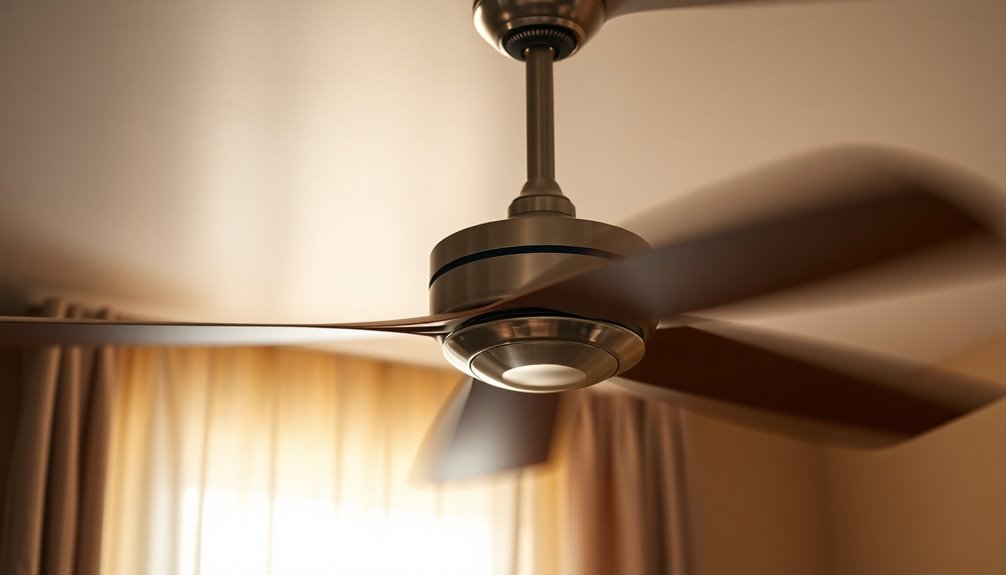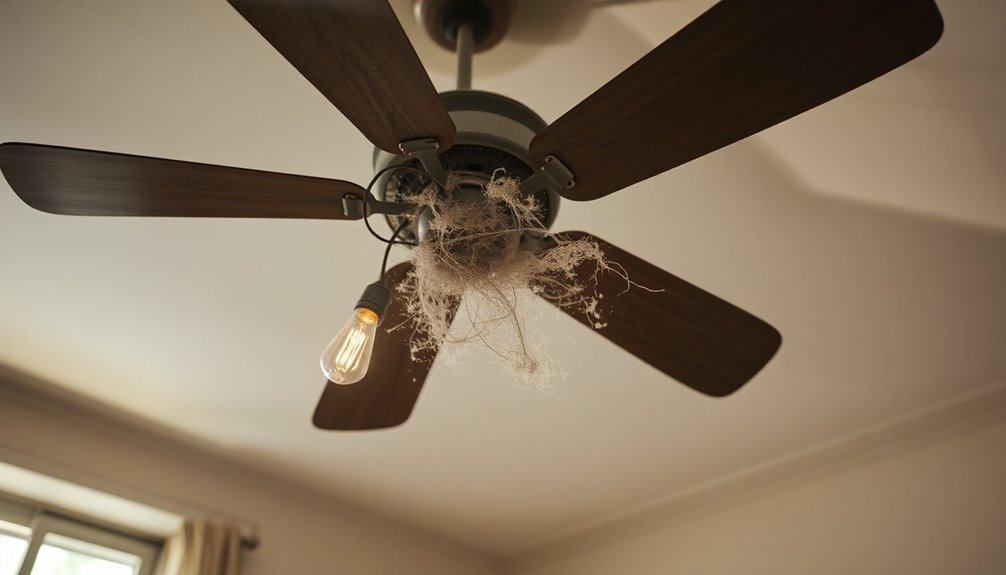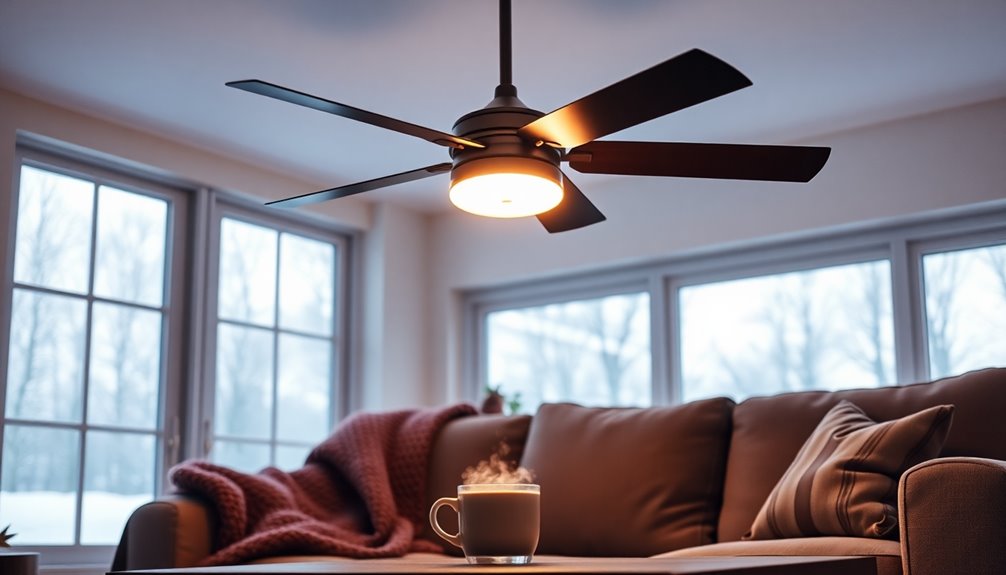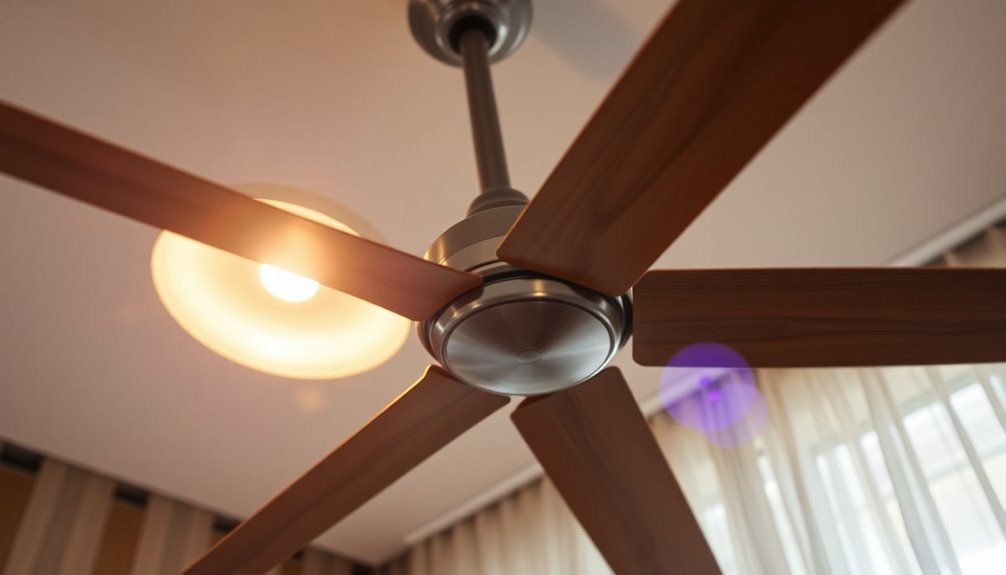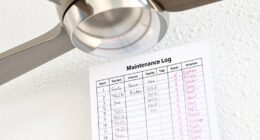If you want a ceiling fan that moves the most air, look for one with a high CFM (Cubic Feet per Minute) rating, ideally exceeding 7,000 CFM for larger spaces. Fans with larger blades and a pitch between 12.5 and 16 degrees efficiently circulate air. Also, consider models with three to five blades for better RPM and aerodynamics to reduce drag. Don't forget energy-efficient motors, which can enhance airflow while conserving energy. Ultimately, choosing the right size and design maximizes your comfort. There's more to explore about selecting the best fan to fit your needs.
Key Takeaways
- Fans with higher CFM ratings, typically exceeding 7,000, are designed for larger spaces, moving more air efficiently.
- Larger blade sizes and pitches between 12.5 to 16 degrees enhance airflow by increasing surface area and drag reduction.
- Fewer blades (3 to 5) increase RPMs, leading to improved air circulation and effective airflow.
- High-quality, energy-efficient motors maximize airflow while minimizing noise, often found in Energy Star-rated models.
- Regular maintenance, including blade cleaning and motor lubrication, optimizes fan performance and airflow over time.
Understanding Airflow and CFM

When it comes to ceiling fans, understanding airflow and CFM is essential for making the right choice for your space. CFM, or Cubic Feet per Minute, measures the volume of air a fan can move.
If you're looking for high CFM, fans exceeding 7,000 CFM are perfect for larger rooms or open spaces that require efficient ventilation. For typical residential use, the preferred CFM generally ranges from 3,000 to 5,000, depending on the room size and specific cooling or heating needs.
Several factors influence a fan's CFM rating and overall effectiveness in air movement, including ceiling fan size, blade pitch, and motor power. A larger fan with the right blade pitch can greatly enhance airflow, ensuring optimal airflow throughout your space.
When selecting a fan, consider how these elements work together to create the desired air movement.
Factors Affecting Airflow Efficiency

When it comes to airflow efficiency, the blade design and motor power of your ceiling fan play vital roles.
A well-designed blade can greatly enhance air movement, while a powerful motor guarantees higher RPM for better circulation.
Blade Design Impact
Blade design plays an essential role in determining the airflow efficiency of ceiling fans. Larger blades typically move more air due to their increased surface area and ability to sweep a larger volume of space.
The blade pitch, or angle at which they're set, is vital too; a steeper pitch of 12.5 to 16 degrees maximizes airflow. You'll find that blade count also affects performance—fans with fewer blades, usually 3 to 5, can achieve higher RPMs, resulting in greater air movement compared to those with more blades that may rotate slower.
Additionally, the shape of the blades matters. Aerodynamic designs promote smoother air passage and reduce drag, enhancing airflow efficiency.
When you choose a fan, consider those made from high-quality, lightweight materials like composites. These allow blades to rotate faster without sacrificing stability, ultimately improving fan performance.
A high-quality motor complements this design, ensuring that the fan operates efficiently across various speeds.
Motor Power Efficiency
While blade design greatly influences airflow, the motor's power efficiency is just as important in maximizing a ceiling fan's performance. The motor power directly impacts airflow efficiency; higher wattage typically leads to greater air movement capabilities. When you choose fans equipped with high-quality motors, you can achieve higher RPM (Revolutions Per Minute), which enhances airflow without increasing noise levels.
Efficient motors also reduce energy consumption while delivering powerful airflow, making them ideal for larger spaces requiring effective ventilation. The materials and design of the motor influence its performance, with heavy-duty motors generally providing stronger airflow and durability. Regular maintenance, such as lubrication and cleaning, guarantees peak motor performance, which directly impacts airflow capabilities.
Here's a quick comparison of motor performance factors:
| Factor | Description |
|---|---|
| Motor Power | Higher wattage increases airflow efficiency |
| RPM | Higher RPM leads to better airflow |
| Energy Consumption | Efficient motors use less energy |
| Maintenance | Regular upkeep enhances performance |
Ideal Ceiling Fan Sizes

Choosing the right ceiling fan size is essential for maximizing airflow and comfort in your space. The size you select impacts airflow efficiency and guarantees you're getting the most out of your fan's powerful motor.
Here's a quick guide to help you choose the ideal ceiling fan size:
- Small Fans (24-42 inches): Best for rooms up to 75 square feet.
- Medium Fans (44-54 inches): Ideal for spaces up to 144 square feet.
- Large Fans (56-72 inches): Necessary for rooms over 144 square feet, especially in open-concept areas.
- General Rule: Aim for 1 inch of fan blade span for every square foot of the room.
High CFM Ceiling Fan Recommendations
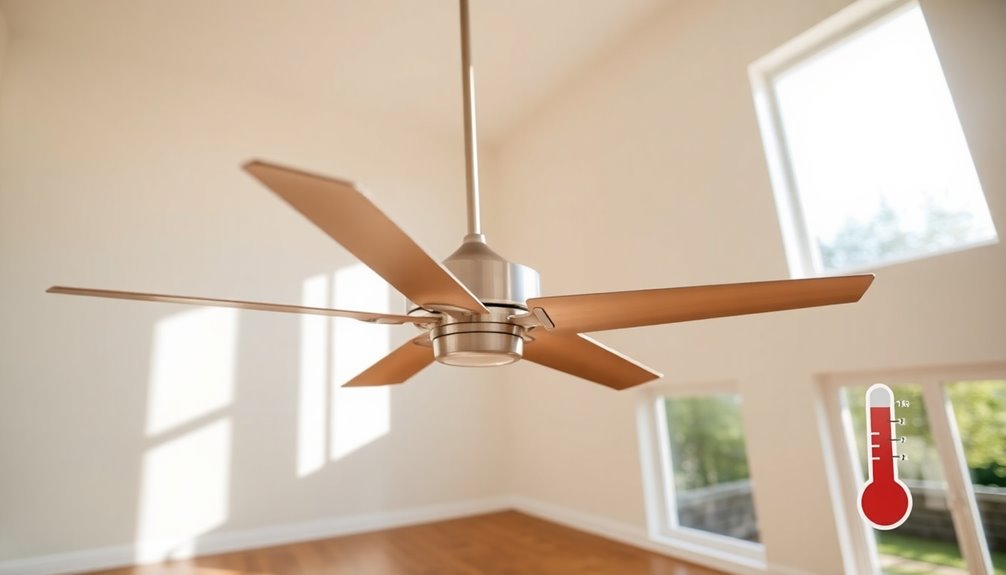
When it comes to cooling large spaces effectively, high CFM (Cubic Feet per Minute) ceiling fans are your best bet, delivering airflow rates that exceed 7,000 CFM. For expansive environments like living rooms and open-concept areas, these fans provide efficient cooling and ideal air circulation.
Here are some top recommendations:
| Fan Model | CFM Rating |
|---|---|
| Icebreaker | 7,000 |
| Daventry | 6,500 |
| Windmaster | 7,200 |
| Cyclone | 7,100 |
When selecting a fan, make sure the blade span is 60 inches or more to maximize airflow efficiency. High CFM ceiling fans typically feature powerful motors and a blade pitch ranging from 12.5 to 16 degrees, greatly enhancing their ability to move air. By choosing the right model, you'll enjoy excellent air circulation, keeping your large rooms comfortable year-round. Don't compromise on your cooling needs; invest in a high CFM ceiling fan for effective airflow and comfort.
Installation and Maintenance Tips

To guarantee your ceiling fan operates at peak efficiency, proper installation and regular maintenance are essential. Follow these tips to ascertain ideal performance and airflow efficiency:
- Ceiling Height: Install your fan 7-9 feet above the floor. This height maximizes airflow and enhances cooling.
- Secure Mounting Bracket: Make sure the mounting bracket is securely attached to a ceiling joist. This prevents wobbling and guarantees stability during operation.
- Clean the Fan Blades: Regularly clean the fan blades to remove dust and debris. This not only helps maintain effective airflow but also reduces noise.
- Lubricate Motor: Regularly check and lubricate the fan motor as needed. This assures smooth operation and extends the lifespan of your fan.
Additionally, don't forget to perform regular checks for loose screws and parts.
If you're using a remote or smart fan, ascertain proper installation of the receiver and monitor battery levels.
Energy Efficiency Considerations
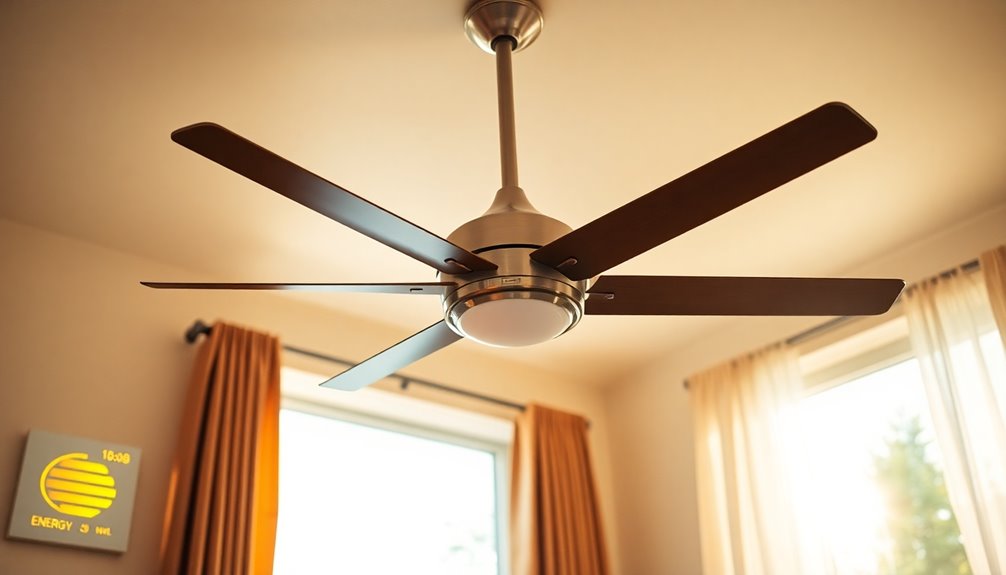
When you choose energy-efficient ceiling fans, you're not just making a smart cooling choice; you're also cutting down on your electricity bills.
These fans often come with energy-saving features that can greatly lower your operating costs.
Energy-Saving Features
Energy-efficient ceiling fans are a smart choice for anyone looking to cut down on electricity costs while maintaining comfort in their home. By choosing a fan with energy-saving features, you can enjoy significant savings and improved airflow.
Here are some key aspects to evaluate:
- High CFM: Fans with a high CFM (cubic feet per minute) rating move more air, providing better cooling without overworking the motor.
- Energy Star Rating: Look for fans with an Energy Star rating, as they meet strict energy efficiency guidelines set by the U.S. Environmental Protection Agency.
- LED Lights: Opt for models that include LED lights, which consume less energy and last longer than traditional incandescent bulbs.
- Advanced Motor Technology: Ceiling fans with advanced motor technology, like DC motors, operate quietly and efficiently, reducing electricity costs while maximizing airflow.
Additionally, many energy-efficient fans come with a reversible motor feature, allowing you to circulate warm air in winter and create cooling breezes in summer.
Operating Cost Analysis
While many homeowners focus on the upfront costs of ceiling fans, understanding their operating costs can lead to greater savings over time. High CFM ceiling fans are particularly effective, as they consume considerably less energy than traditional air conditioning systems, potentially lowering your cooling expenses by up to 30%.
When you choose energy-efficient ceiling fans with Energy Star ratings, you're ensuring lower energy consumption and better air circulation in your home.
Typically, a ceiling fan uses about 70 watts of energy while an air conditioner can consume up to 3,500 watts. This makes ceiling fans a cost-effective option for maintaining comfort without breaking the bank. By using a ceiling fan alongside your air conditioning, you can often raise the thermostat setting by about 4 degrees, further reducing energy consumption.
Regular maintenance, like cleaning and lubricating the motor, can enhance your fan's energy efficiency and prolong its lifespan, leading to even more savings on operating costs.
Frequently Asked Questions
What Type of Ceiling Fan Gives More Air?
When you're looking for a ceiling fan that gives you more air, consider one with a larger blade span, ideally 60 inches or more.
A steeper blade pitch of 12.5 to 20 degrees can boost airflow efficiency, too.
Don't forget about the motor; a high-quality motor helps maintain higher RPMs for better circulation.
Finally, fans designed for high CFM performance, like those with fewer blades, can also greatly enhance airflow in your space.
What Type of Fan Moves the Most Air?
When you're looking for a fan that moves the most air, consider those with larger blade spans and higher RPMs.
Fans designed with a steeper blade pitch can cut through air more effectively, boosting airflow.
Look for models with high-quality motors, as they deliver stronger and quieter performance.
Ceiling fans that achieve high CFM ratings are ideal for larger spaces, ensuring you get the best circulation in your room.
Does a 3 or 5 Blade Fan Move More Air?
When you're deciding between a 3-blade and a 5-blade fan, it's not just about the number of blades.
A well-designed 3-blade fan can spin faster and create a more powerful breeze, while a 5-blade fan might offer smoother airflow and less noise.
Ultimately, you should consider factors like blade pitch and motor quality, as they play a bigger role in airflow than simply counting blades.
Choose based on your specific needs and preferences.
Which Fan Has the Best Airflow?
When you're looking for a fan with the best airflow, consider the CFM rating—it's vital.
Fans that exceed 7,000 CFM are ideal for large spaces. Models like the Icebreaker are engineered for high airflow.
Pay attention to blade size and pitch, too; larger blades with a pitch of 12.5 to 16 degrees optimize performance.
Finally, a quality motor improves both airflow and quiet operation, enhancing your overall comfort.
Conclusion
So, if you want your ceiling fan to double as a wind tunnel, just remember: size matters, and so does CFM. Forget about those dainty, decorative fans that barely rustle a piece of paper. You need a powerhouse that could cool off a sauna. With the right choice, you'll be breezing through the summer like a polar bear on vacation. Just don't forget to install it properly—unless you enjoy the thrill of airborne appliances!
